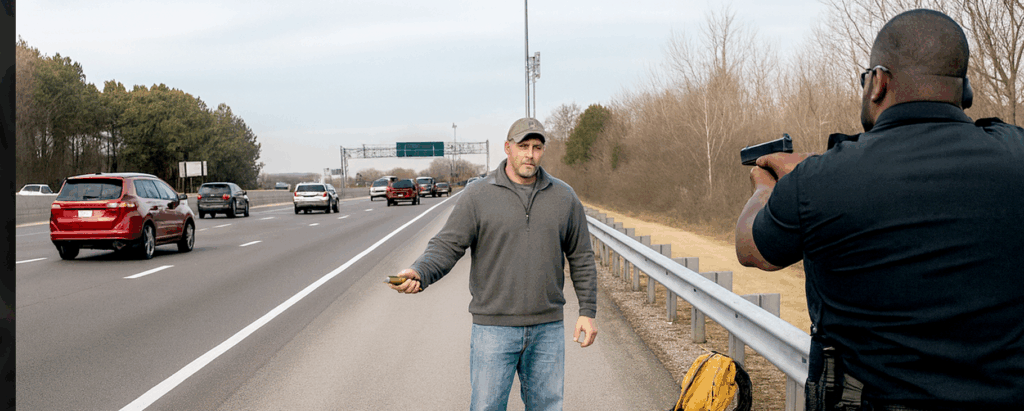Moderson v. City of Neenah, 2025 WL 1355332 (7th Cir. 2025)
On a December morning in Neenah, Wisconsin, law enforcement responded to a report that a long-haired, bearded man dressed in a flannel shirt and armed with a MAC-10 submachine gun, had taken hostages inside a motorcycle shop. Dispatch broadcast that a shot had been fired inside the building and the suspect said he would start killing hostages in five minutes.
As officers established a containment perimeter, a truck fled the scene. Dispatch told the officers the suspect was inside the truck, so some officers left their perimeter positions and moved to intercept the vehicle. As it turned out, the information about the fleeing truck was incorrect. Regrouping, the officers formed a contact team and entered the motorcycle shop.
As they pushed inside, members of the team shouted, “Police,” “Get down,” “Get on the ground now” and “Show me your hands.” One officer reported seeing two men who did not appear in distress moving in opposite directions, consistent with a flanking maneuver. A hail of gunfire followed, accompanied by a cloud of smoke. One officer was struck in the helmet and yelled “I’m hit.” Two more officers fell down an interior stairwell. Another officer used “target-specific directed fire” to provide cover, allowing for the contact team’s retreat from the building. Once outside, the officers realized they were likely facing an ambush as opposed to a hostage situation.
Several hostages, including Ryan Moderson and his fellow plaintiffs, managed to escape. Members of the team detained and questioned them, transporting two to the police station. Soon after, another round of gunfire came from inside the building. Officers spotted an armed man, later identified as Michael Funk, running from the shop building. The man crouched behind a vehicle before taking off across the alley. Officers shot and killed him in the mistaken belief the man was a suspect. (He was actually an escaping hostage.)
Three of these hostages later sued, claiming their detention constituted an unreasonable seizure in violation of their Fourth Amendment rights. The trial court ruled the plaintiffs’ brief “seizure” was reasonable and that no constitutional violation occurred. The court also ruled qualified immunity shielded the officers from liability.
The plaintiffs appealed. In its ruling, the Court of Appeals for the 7th Circuit affirmed the trial court’s decision, holding the officers’ actions were reasonable under the circumstances of a violent hostage situation. Citing the Terry v. Ohio (392 U.S. 1 (1968)) precedent, the 7th Circuit panel noted a police officer who “restrains [a person’s] freedom to walk away has ‘seized’ that person.” All parties agreed the plaintiffs were seized.
The court found the officers were justified in temporarily detaining the plaintiffs to ascertain their identities and ensure safety. Though the plaintiffs claimed to have been arrested without probable cause, the court classified their seizure as “investigative detentions” under the Terry doctrine.
In Terry, the Supreme Court defined an investigative detention (sometimes called a “Terry stop”) as a very limited and narrow exception to the Fourth Amendment warrant requirement. According to the decision in that case, an officer may temporarily detain a person they reasonably believe to be involved in criminal activity. When there is reasonable suspicion the person is armed, the Terry doctrine permits a frisk for the purpose of checking for weapons. Reasonable suspicion, the ruling states, requires “specific and articulable facts which, taken together with rational inferences from those facts, reasonably warrant” a detention. Reasonable suspicion is also measured by the “totality of the circumstances” and from the collective knowledge of the officers involved in the stop (United States v. Sokolow, 490 U.S. 1 (1989)).
The court spent considerable time discussing the failure of the plaintiffs’ attorneys to properly advocate their claim that their clients were “detained without probable cause” (which most rookie cops know is not the proper legal standard for a detention). Embarrassingly, the decision singles out plaintiffs’ counsel for “perfunctory and undeveloped arguments, and arguments that are unsupported by pertinent authority” and “skeletal arguments.” The court held the three plaintiffs were properly detained based on the reasonable suspicion established by the totality of the facts known to the officers at the time and that the duration of the detentions was proper. The appellate court did not need to even consider the question of whether qualified immunity was properly granted because the court held no constitutional violation occurred.
Though this case says plenty about poor lawyering, it also serves as an important reminder that, when dealing with victims, hostages, and witnesses, law enforcement officers should take care to make those contacts voluntary and to communicate clearly that the subjects are not being detained. The best course of action — especially in a weird, chaotic case like this one, where individuals are handcuffed and taken to the police station — is to apologize quickly for the inconvenience and ask for consent for a continued contact.



